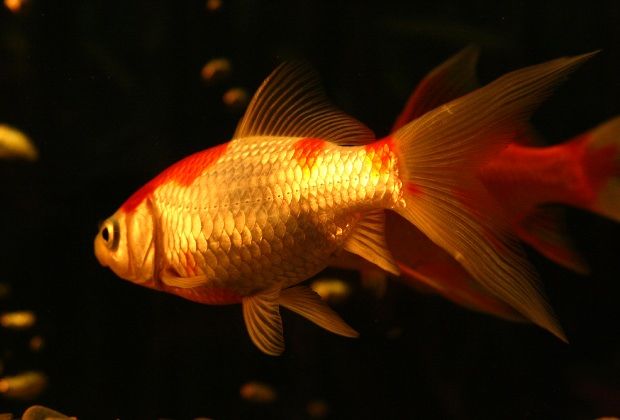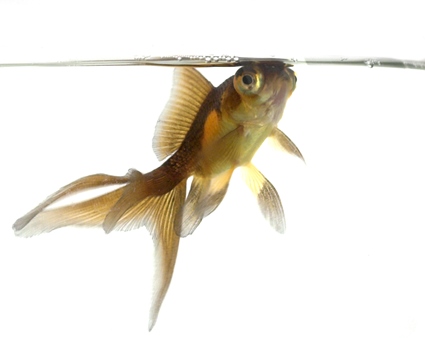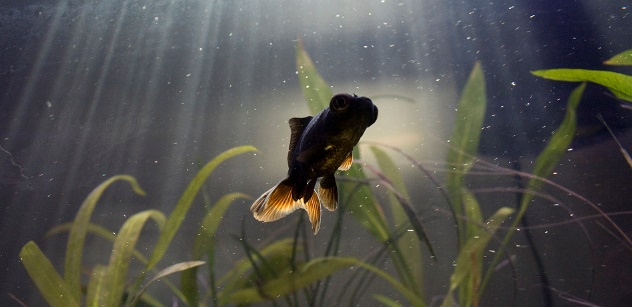
In the second part of the goldfish disease series, we talked about 7 of the most common goldfish ailments that impact freshwater aquariums and ponds. We even looked at 14 goldfish disease symptoms to watch out for.
Now, let’s examine ways to prevent goldfish ailments by pinpointing exactly what caused your goldfish to get sick.
Yes, I know.
You may think you already have it figured out. In the last article, maybe you learned that your goldfish had ich (white spot disease). You probably already killed off the parasites, even.
But have you really treated the problem?
Poor Water Quality: #1 Cause of Goldfish Ailments
Most goldfish fall victim to goldfish diseases when they’re left to swim in murky water conditions, often flooded with poisonous ammonia and unhealthy pH or nitrate levels. You might forget to change the water one week or forgo water tests for a while. You might even give in to your goldfish’s seemingly constant plea for yet another morsel of food.
The next thing you know, your goldfish are on a wild feeding frenzy and pooping out buckets (overfeeding is very bad news for goldfish).
Poor water quality is common, especially in new tanks where goldfish are expected to survive in three-gallon bowls (they can’t, by the way). Poor water quality can also be lethal and cause all sorts of problems (goldfish ailments).
 You’ll know when your goldfish are suffering from unhealthy water conditions when they start spending all of their time at the water line, gasping frantically for oxygen. And if you’re doing weekly water tests like you should, you’ll know the second water conditions start to go downhill.
You’ll know when your goldfish are suffering from unhealthy water conditions when they start spending all of their time at the water line, gasping frantically for oxygen. And if you’re doing weekly water tests like you should, you’ll know the second water conditions start to go downhill.
Water tests are an important part of preventing goldfish ailments before they infect your fish.
To successfully treat goldfish ailments, you’ll need to first eliminate the cause – the reason why your goldfish are sick. If poor water quality is causing your goldfish to act strangely, it’s crucial that you make the aquarium environment healthy again before you start medicating. If you don’t, your goldfish might not recover.
Poor water quality is often caused by overfeeding or overcrowding, but it can also result from negligence. Your goldfish need you! They need a responsible owner who can give them high-quality goldfish care, the type of care that will promote long-lasting lives in a clean aquarium environment.
Before doing anything else, perform a water test. Make sure water readings are in the safe zone. And if they’re not, change 25% of the water. You should also vacuum the substrate thoroughly with a water siphon as you complete water changes. Doing so will remove any uneaten food rotting behind the scenes that could cause goldfish ailments.
You can buy a freshwater test kit at your local pet store or order one online. You can even take a water sample with you to the pet store. But get that water tested.
Depending on what the problem is, you’ll need to take different measures to make the water is safe for your goldfish (and prevent goldfish ailments). In the case of an ammonia spike, solving the problem may be as simple as changing 25% of the water every day until the filter can get things under control.
Once you’ve filled the aquarium with conditioned water (you are treating that tap water right?), sick goldfish will be able to breathe more easily with higher oxygen levels in the aquarium. At this time, you’ll also want to identify what caused your goldfish stress.
In the case of poor water quality, why were the water conditions so unhealthy?
Solving Goldfish Ailments: A Deep Look at the Process
We’ve talked about some pretty nasty goldfish diseases in part 2 of the goldfish disease series. By now, you probably think you have a good idea of what your next action steps should be.
If you haven’t done so already, you should really start thinking about what caused your goldfish to get sick in the first place. Was it poor water quality? If so, what caused the poor water quality? Overfeeding? Overcrowding? What can you do about it?
The goal here is to make sure the problem doesn’t happen again – and avoid goldfish ailments as much as possible. If you leave things how they are, you could be putting your goldfish at risk of another infection.
Let’s walk through the process.
- First, determine the goldfish ailments (what made your fish sick?). Maybe your goldfish are suffering from fin rot. The ends of each fin might have developed cotton-like growths as they’re literally getting eaten away by bacteria.
- Figure out what caused the infection. We already know one of the leading causes of fin rot is poor water quality. After testing the water you discover that an ammonia spike has run rampant in your tank and your goldfish suffered as a result.
- Pinpoint how the water got so out of hand. Thinking back, you remember that you purchased a new goldfish a couple months ago. Could the aquarium be overcrowded?
- Confirm the problem. If you read my goldfish tank guide, you’ll remember that fancy goldfish need at least 10 gallons of water per fish. Your aquarium is only 46 gallons and you already had it stocked with four goldfish before you bought the new calico ryukin goldfish. Now you have five goldfish in a 46 gallon aquarium. Your tank is definitely overcrowded!
- Try to solve the problem. Now what can you do? The best course of action would be to buy a bigger tank, preferably a 60-gallon aquarium. If you’re on a tight budget, get one used. But what if you can’t afford a new tank right now?
- Look for a temporary solution. You might decide to buy a cheap 106 quart Sterilite storage container (about 26.5 gallons, safe for one or two fancy goldfish) to take some weight off of the main aquarium until you can upgrade it. It won’t look nice, but at least your aquarium will no longer be overcrowded. And it will definitely prevent goldfish ailments, keeping water readings on a healthier level until you can afford a bigger aquarium.
- Search for other solutions. Make sure your filter is in good working order. Clean out any waste buildup with hot water (don’t use soap!). You should also rinse out the filter cartridge with aquarium water (don’t use tap water!) to remove excess waste.
- Find other problem areas. You admit that you have been a little lax in water changes lately.
- Fix each new problem. You should probably step up your water changes. You may have to perform more frequent partial water changes (and change 25% of the water three times per week instead of only once per week). You should also schedule your water changes on a calendar so you don’t forget.
- Check if the original problem is fixed. When you test the water, does ammonia stay at 0ppm (parts per million)? If so, you’ve solved the problem! Awesome work. If not, you still may have some fixing up to do. Go back over steps 8 and 9 to find other problem areas.
- Prevent goldfish ailments. You’ve made the aquarium environment safe for goldfish, but you’re not home free yet! What else could you be doing weekly to prevent further water quality issues? For starters, you should always test the water regularly (so you’re aware of uncomfortable water conditions before they cause goldfish ailments). Especially in an overcrowded tank where water can deteriorate quickly.
If you took the temporary solution in the above scenario, you didn’t completely solve the water quality problem but you did improve it.
Make that aquarium purchase a priority. If you absolutely can’t afford a larger goldfish tank, you should give some of your goldfish away to friends who can. To completely treat overcrowding, you’ll need to upgrade your aquarium as soon as possible. Otherwise, your tank will remain overcrowded and susceptible to goldfish ailments.
Are You Asking the Right Questions?
Treating goldfish ailments can be tough, especially the persistent ones that don’t want to leave your aquarium alone.

If a goldfish disease is running rampant in your aquarium, it’s important that you know what caused the problem in the first place. We’ve given you an example in the last section of how this process might look like. But your problem might be very different from the one above.
To solve your unique situation, ask these questions.
- Have I tested the water recently? Freshwater test kits are affordable and many include easy-to-follow instruction manuals that make monitoring the aquarium water simple and painless. You should test your aquarium for ammonia, pH, nitrate, and nitrite weekly to ensure that your water is always safe for your goldfish. I personally use an API Master Test Kit. It works well and lasts a couple years before I have to buy replacements. If the water ever gets out of hand, I’m able to prevent goldfish ailments because I can see immediately what went wrong.
- Have I quarantined new fish or plants for at least two weeks before placing them with my healthy goldfish? If not, make a commitment to quarantine from now on. Parasites are most common in aquariums with new fish, so you don’t want to put all of your healthy goldfish at risk by not taking safety precautions first.
- Did I pour questionable or unconditioned water in the aquarium? Remember to treat tap water with a water conditioner like Prime or AquaSafe each future water change. After purchasing a new fish, never dump water from the plastic bag into your aquarium. If you’re not sure what could be swimming in the water, pour it down the drain.
- Does the aquarium have enough oxygen? Poorly oxygenated water could mean that there’s a problem with your filter. Your filter might be clogged or the filter cartridge could do with a rinsing out. You might even need a new filter if yours is broken or not functioning optimally. Poorly oxygenated water can cause stress and make your fish susceptible to goldfish ailments.
- You should have either a power filter or canister filter for your tank. I personally use a Marineland Penguin Power Filter. It has lasted me years and comes with a bio wheel for extra oxygen.
- Whatever filter you use, you’ll want one with a flow rate (gallons per hour or gph) that is at least 10 times your tank volume. So a 20-gallon aquarium that can keep one or two fancy goldfish will need a filter with a flow rate of around 200 gph.
- It might also help to include an extra air stone or two to keep the water well aerated. Some aquarium decorations have built-in air stones for this purpose.
- Is my aquarium overcrowded? Remember, one or two fancy goldfish are most comfortable in aquariums that can hold a minimum of 20 gallons of water. For each additional fancy goldfish, you should add an extra 10 gallons of water. Otherwise, your goldfish might be susceptible to goldfish ailments. See my goldfish tank guide for more details.
- Have I been doing routine water changes? Depending on water readings, your goldfish tank might require more or less frequent water changes. I personally like to change my aquarium water once per week, and I take out 25% each water change. In addition to this, I test the water weekly and rinse out the filter media with aquarium water during each water change. You might have a similar routine, but make sure you do those water changes!
- Was there a sudden temperature drop in the aquarium? It’s recommended that you never place your goldfish tank near a window for this reason; sudden temperature changes can cause problems for fish. Goldfish ailments are more common when your fish are stressed, so make sure your aquarium either stays at a steady temperature or the temperature doesn’t change too drastically.
- Is my goldfish being fed quality food? If you’re unsure, take a look at my goldfish food guide for tips on what to feed your goldfish. Goldfish need a nutritional diet in order to stay healthy. Make sure you vary the diet to ensure your goldfish are getting the right nutrients. When feeding dry food, I typically alternate between Hikari Lionhead pellets, Omega One Sinking Pellets, and New Life Spectrum Pellets. My goldfish seem to like this combo, since they never know which brand they’re going to get each day. All three brands are very high quality, and I’ve noticed that my goldfish search for food more vigorously since the switch from Tetra food brands.
- Is there uneaten food at the bottom of the tank? You could be overfeeding your goldfish. Avoid goldfish ailments by vacuuming the substrate with a water siphon to remove any uneaten food that might foul the water. This is best done during your weekly water change (or after accidentally overfeeding). If overfeeding is a problem, consider feeding your goldfish less often (and less food per feeding).
These questions were designed to help you puzzle through common goldfish problems. Get in the habit of asking questions and always try to figure out ways you can avoid future goldfish ailments in the aquarium.
Keeping fish healthy is much easier than treating them if they become ill. – David E. Boruchowitz, author of Aquarium Care of Goldfish
Prevention is the key to keeping healthy goldfish that thrive. Remember to quarantine new fish or plants (if bought from an aquarium where fish are present) for at least two weeks before placing them in the same aquarium with healthy goldfish.
Don’t risk the health of your goldfish.
Always maintain a healthy aquarium environment by giving your goldfish the appropriate amount of water to swim around in (10 gallons of water per fancy goldfish), testing the water on a weekly basis, practicing routine water changes, making sure your tank is well oxygenated, and feeding your goldfish a high quality diet to prevent goldfish ailments.
Goldfish that are properly cared for will live long, enriching lives. You owe it to your pets to give them the goldfish care they need to thrive. So observe your goldfish carefully, catch goldfish ailments early, and treat harmful goldfish diseases quickly. Then take preventative measures to keep your goldfish healthy.
What Do You Think?
How do you prevent goldfish ailments? Do you have any tips for first-time goldfish hobbyists? Post your suggestions in the comment box below!


2 comments
M R my Black Moor and Flapper (catfish) is very sick. About 4 days ago they both started getting cottony fungus, redding on there fins and fin rot. They are getting worse. I have been treating them with Melafix and Primafix it is not helping, they are getting worse.
M R and Flapper have been living with us for 3 years now, I have treated them for ick several time and they did great. I did buy a Moss Ball about 2 weeks ago and that is the only thing I have add to there tank.
I need help before it gets to late.
Thank you for any help
Caroline
Hi Caroline,
Have you tested the water with a freshwater test kit? What are water readings?
Fungus and bacterial infections will often develop when there’s a problem with water quality. So first, make sure water conditions are healthy if you haven’t done so already. I’d recommend at least testing for ammonia and pH. If you can, also test for nitrate and nitrite.
For the fungal infection, I recommend Methylene Blue. It’s gentle on sensitive fish and you can couple this with aquarium salt to help reduce stress. From my experience, Pimafix doesn’t treat all fungus infections so you may need to try an anti-fungal medication with different active ingredients.
Before treating the aquarium with another medication, you should change 40% of the water. After that, change 25% of the water for three more days. You want to remove as much of the old medication as you can before treating with another medication. Otherwise, you might over-stress your fish. The water changes will also help you get water conditions back under control if water quality caused the infection. I still recommend testing the water if you haven’t already done so.
You can also start treating the water with aquarium salt in the meantime as you complete each water change. Since salt doesn’t evaporate, only treat the water with aquarium salt after a water change (once you’ve treated the water initially).
Likely the fin rot will heal after your fish are no longer stressed from the fungal infection. But if it doesn’t, you should change the water daily for 4 – 6 days like you did before and treat the aquarium with an anti-bacterial medication. I personally recommend Maracyn-Two for bacteria. You might not need an additional medication for fin rot though, so treat the water for fungus first (unless the fin rot is real bad and fins are deteriorating to the base).
If fin rot is severe, you might want to medicate the aquarium with an anti-bacterial treatment first – if the fins deteriorate to the base, your fish won’t be able to grow them back.
Good luck! I hope your fish have a speedy recovery.